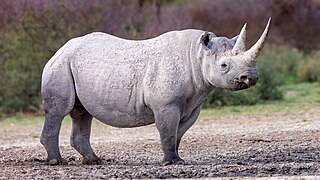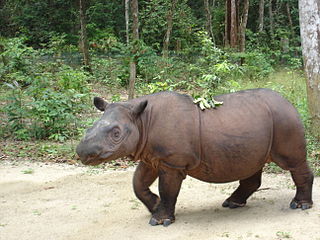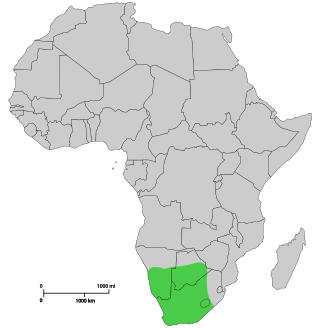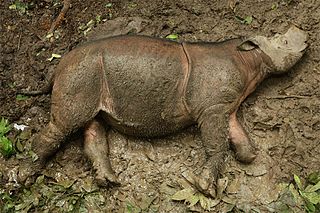
Perissodactyla is an order of ungulates. The order includes about 17 living species divided into three families: Equidae, Rhinocerotidae (rhinoceroses), and Tapiridae (tapirs). They typically have reduced the weight-bearing toes to three or one of the five original toes, though tapirs retain four toes on their front feet. The nonweight-bearing toes are either present, absent, vestigial, or positioned posteriorly. By contrast, artiodactyls bear most of their weight equally on four or two of the five toes: their third and fourth toes. Another difference between the two is that perissodactyls digest plant cellulose in their intestines, rather than in one or more stomach chambers as artiodactyls, with the exception of Suina, do.

In Africa, the Big five game animals are the lion, leopard, rhinoceros, elephant, and African buffalo. The term was coined by big-game hunters to refer to the five most difficult animals in Africa to hunt on foot, but is now more widely used by game viewing tourists and safari tour operators. They are examples of charismatic megafauna, featuring prominently in popular culture, and are among the most famous of Africa's large animals.

The Javan rhinoceros, Javan rhino, Sunda rhinoceros or lesser one-horned rhinoceros is a critically endangered member of the genus Rhinoceros, of the rhinoceros family, Rhinocerotidae, and one of the five remaining extant rhinoceros species across South Asia and Africa. The Javan rhinoceros is one of the smallest rhinoceros species, along with the Sumatran, or "hairy", rhinoceros. They are superficially similar to Indian rhinos, as they have plate-like, "armored" protective skin folds, but are slightly smaller in size, at just 3.1–3.2 m (10–10 ft) long and 1.4–1.7 m (4.6–5.6 ft) tall, on average. The heaviest specimens weigh around 2,300 kg/2.3 tonnes, similar to a black rhinoceros. However, unlike the long and potentially lethal horns of the black or white rhinoceroses of Africa, the Javan species' single, somewhat blunted horn is usually shorter than 25 cm (9.8 in).

The black rhinoceros, black rhino or hook-lipped rhinoceros is a species of rhinoceros, native to eastern and southern Africa including Angola, Botswana, Kenya, Malawi, Mozambique, Namibia, South Africa, Eswatini, Tanzania, Zambia, and Zimbabwe. Although the species is referred to as black, its colours vary from brown to grey. It is the only extant species of the genus Diceros.

The Sumatran rhinoceros, also known as the Sumatran rhino, hairy rhinoceros or Asian two-horned rhinoceros, is a rare member of the family Rhinocerotidae and one of five extant species of rhinoceros; it is the only extant species of the genus Dicerorhinus. It is the smallest rhinoceros, although it is still a large mammal; it stands 112–145 cm (44–57 in) high at the shoulder, with a head-and-body length of 2.36–3.18 m and a tail of 35–70 cm (14–28 in). The weight is reported to range from 500–1,000 kg (1,100–2,200 lb), averaging 700–800 kg (1,540–1,760 lb). Like both African species, it has two horns; the larger is the nasal horn, typically 15–25 cm (5.9–9.8 in), while the other horn is typically a stub. A coat of reddish-brown hair covers most of the Sumatran rhino's body.

A rhinoceros, commonly abbreviated to rhino, is a member of any of the five extant species of odd-toed ungulates in the family Rhinocerotidae; it can also refer to a member of any of the extinct species of the superfamily Rhinocerotoidea. Two of the extant species are native to Africa, and three to South and Southeast Asia.

The Indian rhinoceros, also known as the greater one-horned rhinoceros, great Indian rhinoceros, or Indian rhino for short, is a rhinoceros species native to the Indian subcontinent. It is the second largest extant species of rhinoceros, with adult males weighing 2.07–2.2 tonnes and adult females 1.6 tonnes. The skin is thick and is grey-brown in colour with pinkish skin folds. They have a single horn on their snout that grows to a maximum of 57.2 cm (22.5 in). Their upper legs and shoulders are covered in wart-like bumps. They are nearly hairless, aside from the eyelashes, ear fringes and tail brush.

Diceros is a genus of rhinoceros containing the extant black rhinoceros (Diceros bicornis) and several extinct species.

The white rhinoceros, white rhino or square-lipped rhinoceros is the largest extant species of rhinoceros. It has a wide mouth used for grazing and is the most social of all rhino species. The white rhinoceros consists of two subspecies: the southern white rhinoceros, with an estimated 16,803 wild-living animals, and the much rarer northern white rhinoceros. The northern subspecies has very few remaining individuals, with only two confirmed left in 2018. Sudan, the world's last known male northern white rhinoceros, died in Kenya on 19 March 2018 at age 45.

The northern white rhinoceros or northern white rhino is one of two subspecies of the white rhinoceros. This subspecies is a grazer in grasslands and savanna woodlands. Formerly found in several countries in East and Central Africa south of the Sahara, since 19 March 2018, there are only two known rhinos of this subspecies left, named Najin and Fatu, both of which are female; barring the existence of unknown or misclassified male northern white rhinos elsewhere in Africa, this makes the subspecies functionally extinct. The two female rhinos belong to the Dvůr Králové Zoo in the Czech Republic but live in the Ol Pejeta Conservancy in Kenya where they are protected by armed guards.

The eastern black rhinoceros, also known as the East African black rhinoceros, is a subspecies of the black rhinoceros. Its numbers are very low due to poaching for its horn, and it is listed as critically endangered.

The south-central black rhinoceros, also known as the south-central hook-lipped rhinoceros or the lesser black rhino, is a subspecies of the black rhinoceros. In keeping with the rules of zoological nomenclature, the south-central black rhinoceros should be known as Diceros bicornis keitloa, a nomen novum. Although it is the most numerous of the black rhinoceros subspecies, it is nevertheless designated as critically endangered on the IUCN Red List. Like other black rhinoceros subspecies, it has a prehensile lip and lives in savanna habitat.

The south-western black rhinoceros is a subspecies of the black rhinoceros, living in southwestern Africa. It is currently listed as near threatened by the IUCN. The biggest threat towards the subspecies is illegal poaching.

Functional extinction is the extinction of a species or other taxon such that:
- It disappears from the fossil record, or historic reports of its existence cease;
- The reduced population no longer plays a significant role in ecosystem function;
- The population is no longer viable. There are no individuals able to reproduce, or the small population of breeding individuals will not be able to sustain itself due to inbreeding depression and genetic drift, which leads to a loss of fitness.

The southern black rhinoceros, southern hook-lipped rhinoceros or Cape rhinoceros is an extinct subspecies of the black rhinoceros that was once abundant in South Africa from the Cape Province to Transvaal, southern Namibia, and possibly also Lesotho and southern Botswana. Zoos, animal sanctuaries and conservation centers use this same scientific name as an indicating reference to the surviving south-central black rhinoceros. This former species was brought to extinction by excessive hunting and habitat destruction around 1850.

The southern white rhinoceros or southern white rhino is one of the two subspecies of the white rhinoceros. It is the most common and widespread subspecies of rhinoceros.

The Bornean rhinoceros, also known as the eastern Sumatran rhinoceros or eastern hairy rhinoceros, is one of three subspecies of Sumatran rhinoceros. The subspecies was feared to be functionally extinct, with only one individual, a female named Pahu, surviving in captivity, and held in the state of Sabah. In April 2015, the Malaysian government declared the Bornean rhinoceros to be extinct in the wild in the Malaysian portion of Borneo. However, in March 2016, a young female rhino was captured in East Kalimantan, providing evidence of their continued existence. The International Union for Conservation of Nature (IUCN) classifies the subspecies as critically endangered.

Many species are affected by poaching, including illegal hunting, fishing and capturing of wild animals, and, in a recent usage, the illegal harvesting of wild plant species. The article provides an overview of species currently endangered or impaired by poaching in the Americas, sub-Saharan Africa, and South-East Asia.

The Vietnamese Javan rhinoceros, also known as the Indo-Chinese Javan rhinoceros, is an extinct subspecies of the Javan rhinoceros that formerly lived in Laos, Cambodia, Thailand, Malaysia, and Vietnam. The subspecific term annamiticus derives from the Annamite name of the Indochinese Mountains in Indochina, part of the historical distribution of the subspecies.

Rhinoceros poaching in southern Africa is the illegal act of slaughtering rhinoceros in the southern African countries of Namibia, Botswana, Zimbabwe and South Africa, where most of Africa's rhinos live. The most common reason for rhino poaching is to meet the high demand for their horns in Asian countries, where the horn is predominantly used in Traditional Chinese Medicine but is increasingly being used as a symbol of wealth and prosperity. In previous generations, the most common rhino poaching activity was hunting for recreational purposes. Because of excessive poaching, rhino populations have decline rapidly since the 1970s, leaving some species critically endangered and facing extinction.





















